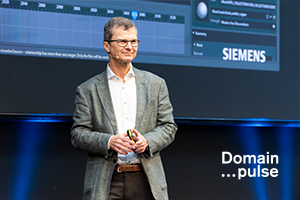/ „It’s an evolutionary process“

/ nic.at News - 18.07.2024 09:17
„It’s an evolutionary process“
At the Domain pulse event in Vienna, participants were given insights into the application of new technologies. Norbert Gaus of Siemens detailed how the industrial metaverse integrates the real and digital worlds. Alexander Mayrhofer, who leads the R&D department at nic.at, explored new ways to use domains within social media.
Is this the future of urban planning? Posing this question and using “A digital twin of an entire city district” as an example, Norbert Gaus, Executive Vice President at Siemens responsible for Research and Predevelopment, provided insights into Siemens' future technologies at this year’s Domain pulse in Vienna. A digital twin of a city allows for the pre-simulation of urban planning. “Every single building has a digital twin. We are pioneering entirely new methods,” Gaus highlighted. This technology has the potential to optimize traffic flow and decrease energy consumption.
Synchromized Lifecycle
“The next evolution of the digital twin is the industrial metaverse,” stated Gaus. This initiative aims to seamlessly integrate the real and digital worlds throughout their entire lifecycle, ensuring they are always synchronized. “This approach can address real-world challenges,” Gaus believes. While the Metaverse is often linked with virtual realms in entertainment or social networking, it is increasingly being utilized in industry. “The industrial metaverse market will expand much quicker than the consumer segment,” Gaus forecasted. Such advancements, however, depend on a robust ecosystem: “It's an evolution, not a revolution.” Emerging technologies like AI and blockchain will be essential. “Collaboration is crucial as no company can manage this complexity alone.” Siemens is facilitating this through the Siemens Xcelerator, a digital transformation ecosystem that connects various partners. Although the industrial metaverse remains a visionary concept, its potential is vast: it could lead to energy conservation, reduced resource use, minimized waste, and major efficiency gains.
New Uses for Domains
Alexander Mayrhofer, head of Research & Development at nic.at, investigated the contemporary applications of domains. What are domains currently utilized for? At .at, 54.8 percent are categorized as High Content Domains. "This means nearly 55 percent of these domains support content – like websites – that are both maintained and actively used," said Mayrhofer. Content is inaccessible in 21.9 percent of domains, while 21 percent qualify as Low Content Domains.
Furthermore, Mayrhofer examined domain usage within social media. While popular networks like Instagram or X (formerly Twitter) do not allow custom domains as usernames, platforms such as Mastodon and Bluesky do allow them for user identification and as usernames. Mayrhofer noted that this opens up significant possibilities, particularly in marketing and branding. Bluesky offers "more appealing handles" and ensures complete account portability. At present, 75 percent of all domains are used for web and email services. Will this trend shift in the future? “Other applications are either unknown or not prominently visible,” highlighted Mayrhofer.
It is therefore not yet clear where the path will lead in the future. Using your own domain name as a username in social networks certainly has its advantages: The domain name is used for verification. This means you can use all AT Protocol-based services with the same identity using the domain name. The number of Mastodon and Bluesky users is still low, as Mayrhofer emphasized. However, this could change quickly.
Current statistics on High and Low Content Domains can be found at the nic.at website.
Picture (c) Anna Rauchenberger